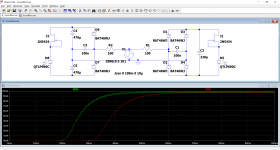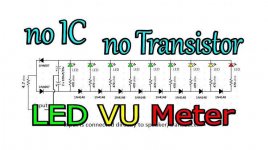In a concert hall, the level will be substantial.It's for a concert hall, the idea is only to enhance the visual presence of the speaker.
I understand some batteries would do the job but I think it would be a much elegant design if the energy could be taken from the audio signal.
All you need is a small bridge rectifier made of schottky diodes, isolated by a 100 ohm pre-limiting resistor, a largish filter/memory cap, a CCS limiter and a LED.
It will only go off during the complete silence periods
Here are two example circuits; you may need to adapt the values to suit your exact requirements, but it should provide you with a working, starting base.
The circuit on the left uses a doubler, and should react at ~1/2 the level of the one on the right.
The choice depends on the output power of the amplifiers.

The circuit on the left uses a doubler, and should react at ~1/2 the level of the one on the right.
The choice depends on the output power of the amplifiers.
Attachments
I have used red LED in series with 10R, observing proper polarity. I won't recommend cap in parallel for obvious reasons coz direct cap on any amp output is a big NO-NO , may lead to instability.
How to make VU Meter without any ic without transistors without PCB - YouTube
I have not yet tested this circuit, It uses 2 caps
This is really cool... I'm going to play with this. Stupid question: What's the function of the zener diodes?
This is really cool... I'm going to play with this. Stupid question: What's the function of the zener diodes?
I don't know, I can't just see what they could possibly do.
First thought is reverse voltage protection for the LED's but 20 volts is high and ordinary diodes would 100% block everything negative. In normal forward biased mode both work with a similar forward volt drop and provide the incremental steps to light the LED's in sequence.
Think of it at DC and what happens if you applied +100 volts DC across the series caps and then -100 volts. The first Zener would conduct at 20 volts + the LED breakdown voltage when reverse biased...
So no idea what he is thinking on that.
This shows the total rail voltage (V+ and v-) available for the LED's and the LED currents in response to a 5 volt peak sine input lasting 200 cycles at 1kHz. The LED models do not correctly conduct at breakdown in a reverse direction but if you are interested then you can either short them or parallel them with Zeners and diodes to approximate a breakdown condition when reverse biased.
Attachments
Hi Mooly How Are You?? And What Is The Name Of Software You Are Using???I don't know, I can't just see what they could possibly do.
First thought is reverse voltage protection for the LED's but 20 volts is high and ordinary diodes would 100% block everything negative. In normal forward biased mode both work with a similar forward volt drop and provide the incremental steps to light the LED's in sequence.
Think of it at DC and what happens if you applied +100 volts DC across the series caps and then -100 volts. The first Zener would conduct at 20 volts + the LED breakdown voltage when reverse biased...
So no idea what he is thinking on that.
This shows the total rail voltage (V+ and v-) available for the LED's and the LED currents in response to a 5 volt peak sine input lasting 200 cycles at 1kHz. The LED models do not correctly conduct at breakdown in a reverse direction but if you are interested then you can either short them or parallel them with Zeners and diodes to approximate a breakdown condition when reverse biased.
It is LTspice. Click my signature line to see how to get started.Hi Mooly How Are You?? And What Is The Name Of Software You Are Using???
(... And just turn your phone, if using one, by 90 degrees to see it!)Click my signature line
Thanks 🙂It is LTspice. Click my signature line to see how to get started.
- Home
- Design & Build
- Construction Tips
- Powering a LED from the input signal in a passive loudspeaker?


